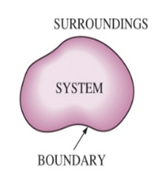
Week 1: Introduction of Thermodynamics
Thermodynamics is the study of the energy, principally heat energy, that accompanies chemical or physical changes. Some chemical reactions release heat energy; they are called exothermic reactions, and they have a negative enthalpy change. Others absorb heat energy and are called endothermic reactions, and they have a positive enthalpy change. But thermodynamics is concerned with more than just heat energy. The change in level of organization or disorganization of reactants and products as changes take place is described by the entropy change of the process. For example, the conversion of one gram of liquid water to gaseous water is in the direction of increasing disorder, the molecules being much more disorganized as a gas than as a liquid. The increase in disorder is described as an increase in entropy, and the change in entropy is positive. Whether a chemical reaction or physical change will occur depends on both the enthalpy and entropy of the process, which are quantities that can be calculated from tabulated data. Both terms are combined in the free energy—the third and most important thermodynamic term. If the change in free energy is negative, the reaction will proceed to the right; this reaction is called a spontaneous reaction. If the sign is positive, the reaction will not proceed as written; this reaction is nonspontaneous. A powerful prediction as to whether a reaction will or will not take place can be made using tabulated data to calculate the change in free energy.


